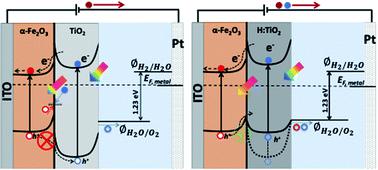Our official English website, www.x-mol.net, welcomes your
feedback! (Note: you will need to create a separate account there.)
Hydrogen induced interface engineering in Fe2O3–TiO2 heterostructures for efficient charge separation for solar-driven water oxidation in photoelectrochemical cells
RSC Advances ( IF 3.9 ) Pub Date : 2021-1-21 , DOI: 10.1039/d0ra09655e Aadesh P Singh 1 , Richard Baochang Wang 2 , Camilla Tossi 1 , Ilkka Tittonen 1 , Björn Wickman 2 , Anders Hellman 2
RSC Advances ( IF 3.9 ) Pub Date : 2021-1-21 , DOI: 10.1039/d0ra09655e Aadesh P Singh 1 , Richard Baochang Wang 2 , Camilla Tossi 1 , Ilkka Tittonen 1 , Björn Wickman 2 , Anders Hellman 2
Affiliation

|
Semiconductor heterostructure junctions are known to improve the water oxidation performance in photoelectrochemical (PEC) cells. Depending on the semiconductor materials involved, different kinds of junctions can appear, for instance, type II band alignment where the conduction and valence bands of the semiconductor materials are staggered with respect to each other. This band alignment allows for a charge separation of the photogenerated electron–hole pairs, where the holes will go from low-to-high valance band levels and vice versa for the electrons. For this reason, interface engineering has attracted intensive attention in recent years. In this work, a simplified model of the Fe2O3–TiO2 heterostructure was investigated via first-principles calculations. The results show that Fe2O3–TiO2 produces a type I band alignment in the heterojunction, which is detrimental to the water oxidation reaction. However, the results also show that interstitial hydrogens are energetically allowed in TiO2 and that they introduce states above the valance band, which can assist in the transfer of holes through the TiO2 layer. In response, well-defined planar Fe2O3–TiO2 heterostructures were manufactured, and measurements confirm the formation of a type I band alignment in the case of Fe2O3–TiO2, with very low photocurrent density as a result. However, once TiO2 was subjected to hydrogen treatment, there was a nine times higher photocurrent density at 1.50 V vs. the reversible hydrogen electrode under 1 sun illumination as compared to the original heterostructured photoanode. Via optical absorption, XPS analysis, and (photo)electrochemical measurements, it is clear that hydrogen treated TiO2 results in a type II band alignment in the Fe2O3–H:TiO2 heterostructure. This work is an example of how hydrogen doping in TiO2 can tailor the band alignment in TiO2–Fe2O3 heterostructures. As such, it provides valuable insights for the further development of similar material combinations.
中文翻译:

Fe2O3-TiO2 异质结构中的氢诱导界面工程可实现光电化学电池中太阳能驱动水氧化的有效电荷分离
众所周知,半导体异质结构结可以提高光电化学(PEC)电池中的水氧化性能。根据所涉及的半导体材料,可能会出现不同类型的结,例如,II 型能带排列,其中半导体材料的导带和价带彼此交错。这种能带排列允许光生电子-空穴对的电荷分离,其中空穴将从低价带水平移动到高价带水平,电子反之亦然。因此,界面工程近年来引起了人们的广泛关注。在这项工作中,通过第一性原理计算研究了 Fe 2 O 3 –TiO 2异质结构的简化模型。结果表明,Fe 2 O 3 –TiO 2在异质结中产生I型能带排列,这不利于水氧化反应。然而,结果还表明,间隙氢在TiO 2中是能量允许的,并且它们引入价带以上的态,这有助于空穴通过TiO 2层的传输。 作为响应,制造了明确的平面 Fe 2 O 3 –TiO 2异质结构,并且测量证实了在 Fe 2 O 3 –TiO 2的情况下形成了 I 型能带排列,因此具有非常低的光电流密度。然而,一旦对TiO 2进行氢处理,与原始异质结构光电阳极相比,在1个太阳光照下,在1.50V电压下可逆氢电极的光电流密度高出九倍。通过光学吸收、XPS 分析和(光)电化学测量,很明显氢处理的 TiO 2会导致 Fe 2 O 3 –H:TiO 2异质结构中的 II 型能带排列。这项工作是一个例子,说明 TiO 2中的氢掺杂如何调整 TiO 2 -Fe 2 O 3异质结构中的能带排列。因此,它为进一步开发类似材料组合提供了宝贵的见解。
更新日期:2021-01-21
中文翻译:

Fe2O3-TiO2 异质结构中的氢诱导界面工程可实现光电化学电池中太阳能驱动水氧化的有效电荷分离
众所周知,半导体异质结构结可以提高光电化学(PEC)电池中的水氧化性能。根据所涉及的半导体材料,可能会出现不同类型的结,例如,II 型能带排列,其中半导体材料的导带和价带彼此交错。这种能带排列允许光生电子-空穴对的电荷分离,其中空穴将从低价带水平移动到高价带水平,电子反之亦然。因此,界面工程近年来引起了人们的广泛关注。在这项工作中,通过第一性原理计算研究了 Fe 2 O 3 –TiO 2异质结构的简化模型。结果表明,Fe 2 O 3 –TiO 2在异质结中产生I型能带排列,这不利于水氧化反应。然而,结果还表明,间隙氢在TiO 2中是能量允许的,并且它们引入价带以上的态,这有助于空穴通过TiO 2层的传输。 作为响应,制造了明确的平面 Fe 2 O 3 –TiO 2异质结构,并且测量证实了在 Fe 2 O 3 –TiO 2的情况下形成了 I 型能带排列,因此具有非常低的光电流密度。然而,一旦对TiO 2进行氢处理,与原始异质结构光电阳极相比,在1个太阳光照下,在1.50V电压下可逆氢电极的光电流密度高出九倍。通过光学吸收、XPS 分析和(光)电化学测量,很明显氢处理的 TiO 2会导致 Fe 2 O 3 –H:TiO 2异质结构中的 II 型能带排列。这项工作是一个例子,说明 TiO 2中的氢掺杂如何调整 TiO 2 -Fe 2 O 3异质结构中的能带排列。因此,它为进一步开发类似材料组合提供了宝贵的见解。











































 京公网安备 11010802027423号
京公网安备 11010802027423号